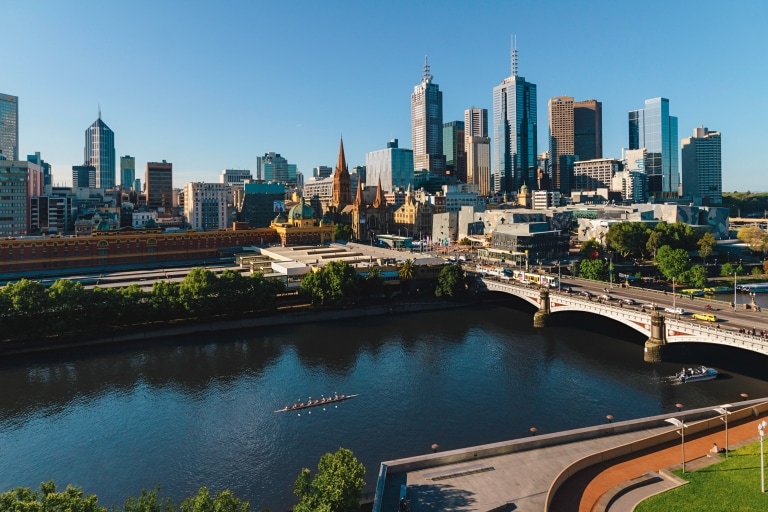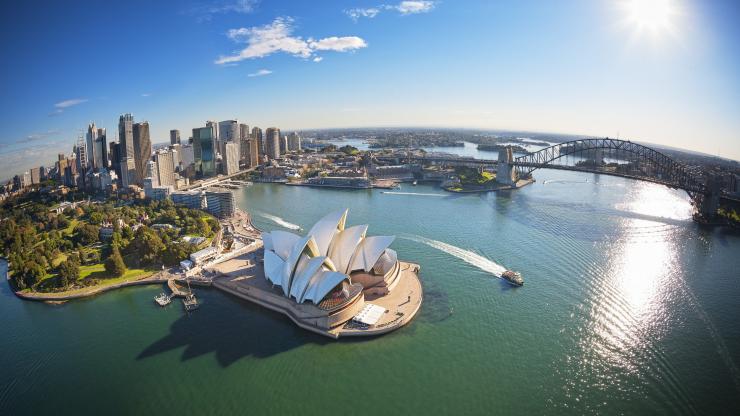
8-day Sydney to Melbourne inland drive
Driving between Australia’s two largest cities, Sydney and Melbourne, offers the perfect way to explore Australia’s cultural heart.
By Mark Chipperfield
The drive between Sydney and Melbourne offers a lot more than big skies and beautiful landscapes. Beach-lovers can take the coastal route, but consider heading inland to explore some of the lesser-known attractions along this iconic road trip. On this eight-day trip, uncover some of the nation’s most prestigious collections of museums, art galleries and cultural centres, take the kids panning for gold, explore architecturally beautiful towns and more.
What to expect
- Sailing on iconic Sydney Harbour
- Foraging for Canberra’s exquisite truffles
- Family fun at beautiful Sovereign Hill
Fast facts
- Time: 8 days
- Distance: 878 kilometres (546 miles)
- Transport: car
- Nearest major city: Sydney
- Price: $$
Day 1: Sydney

Sydney Harbour, Sydney, New South Wales © Destination NSW
Sydney is a city that rises early. If you wish, you and the kids can join the energetic locals for a sunrise walk around the Sydney Opera House and Botanic Gardens, or perhaps a swim at Bondi Beach. Follow up with an indulgent breakfast at one of the city’s many eateries. Bills is Sydney’s most celebrated breakfast joint (try its world-famous ricotta hotcakes); for something a little edgier, try Devon Café where the breakfast menu ranges from buckwheat blinis to yakuza burgers. Round off your morning with a backstage tour of the Sydney Opera House. Designed by Danish architect Jørn Utzon in 1957, the opera house is regarded as a 20th-century design masterpiece. Next, jump on the ferry to Manly, a beachside suburb located at the entrance to Sydney Harbour. The trip takes in some of the city’s best-known landmarks, such as the Sydney Harbour Bridge, Fort Denison and Taronga Zoo Sydney for roughly AUD $15 per adult, return (children cost less). You’ll also see some of Sydney’s most expensive real estate, including Admiralty House. This elegant colonial villa, which dates from 1843, is the official Sydney residence of Australia’s head of state, the Governor-General. Laidback Manly offers safe swimming, family-friendly dining and plenty of people watching.
Day 2: Sydney to Bowral

The Bradman Museum, Bowral, New South Wales © Destination NSW
Pick up a rental car this morning and motor southwest. Less than a two-hour drive from Sydney, the Southern Highlands is known for its picturesque villages, green fields, antiques shops and small wineries. Families with small children should stop at the NSW Rail Museum in Thirlmere. Continue to Bowral. Cricket fans will want to explore the Bradman Museum on Jude Street which contains a vast collection of memorabilia associated with Sir Donald Bradman, Australia’s most famous batsman – the museum overlooks the oval where The Don began his career.
After lunch, drive out to the well-preserved 19th-century village of Berrima – the historic Courthouse Museum and Berrima Gaol are both worth visiting. If you are feeling adventurous, continue north to Wombeyan Caves. These popular limestone caves are located on the southern fringe of the Kanangra-Boyd National Park. Fitzroy Falls, another beauty spot, is closer to Bowral and also means that you can stop off at the much-loved Burrawang Village Hotel on the return leg. The pub serves robust country fare and a good selection of beers, ales and wines – and there are rooms upstairs if you'd like to settle in for the night. If you're after something a bit more upscale, book dinner at Onesta Cucina and enjoy their scrumptious Italian fare.
Day 3: Bowral to Canberra

Poachers Pantry, Murrumbateman, New South Wales © Robert Coppa
The 168-kilometre (104-mile) drive from Bowral to Canberra is a delightful experience, so take your time. Goulburn, home of the 15-metre (49-foot) high Big Merino, is the first major town you’ll encounter. Local attractions include the Rocky Hill War Memorial, St Saviour’s Cathedral and the Historic Waterworks Museum. Pick up something warm for those chilly winter nights at The House of Alpaca. If you’re feeling peckish drive south to Lerida Estate on the shores of Lake George. The popular vineyard café offers a tasty seasonal menu – estate wines are available at the cellar door.
The countryside north of the capital is worth exploring in the afternoon. Apart from delightful hamlets such as Hall, Gundaroo and Murrumbateman you’ll find some of the region’s best wine producers here. Mount Majura, Tallagandra Hill, Gallagher Wines and Shaw Vineyard Estate are all respected producers. For a special treat, however, make your way to Poachers Pantry. This country smokehouse has been a favourite haunt for Canberrans for over two decades – order the Poachers charcuterie board paired with a glass of Wily Trout pinot noir or shiraz.
Day 4: Canberra and surrounds

Aboriginal Memorial, National Gallery of Australia, Canberra, Australian Capital Territory © VisitCanberra
Designed by the American architect Walter Burley Griffin, Canberra has often been portrayed as a soulless garden city. The reality is quite different. The national capital is not only superbly planned, but contains most of Australia’s most important cultural icons. Pre-eminent is the National Gallery of Australia (NGA), one of the finest collections of artwork on the planet. Equally impressive is the Australian War Memorial. No visit to Canberra is complete without visiting the Hall of Memory and the Tomb of the Unknown Australian Soldier.
Although life in Canberra revolves around politics – tours of Parliament House are also available – this is a city which knows how to have fun. Hire a bike and go for an afternoon ride around Lake Burley Griffin, take a glass-blowing class at Canberra Glassworks or try your hand at a spot of truffle hunting. There are several truffle farms nearby and the city also hosts a Truffle Festival every winter. And there’s plenty to keep the kids amused. Options include Cockington Green Gardens, Questacon (science and technology), the National Zoo & Aquarium and the Australian Institute of Sport, home of Australia’s top athletes; visitors can use the centre’s two Olympic pools.
Day 5: Canberra to Wagga Wagga

Botanic Gardens, Wagga Wagga, New South Wales © Destination NSW
Try to get an early start for the next leg of your journey which requires you to head north, skirting Kosciuszko National Park, travelling to Yass and then onto Gundagai and Wagga Wagga. The rural town of Yass is a good place to stretch your legs before tackling the rest of your journey. The prosperous community has a good selection of cafes and gift shops. In warm weather you can cool off in the town’s swimming pool. Next stop is Gundagai, which is immortalised in the poem by Jack Moses – if you’re looking for the Dog on the Tuckerbox memorial it’s actually eight kilometres (five miles) north of the town, just off the Hume Highway.
Gundagai dates back to the Gold Rush and is steeped in history – the bushranger Captain Moonlite is buried in the local cemetery. Pick up a self-guided walking tour of the main street from the Information Centre. Continue your journey to Wagga Wagga, capital of the Riverina region. Highlights include the Botanic Gardens, the Museum of the Riverina and a miniature railway for the little ones. Wagga Wagga Art Gallery has a fine collection of Australian prints and contemporary glass and also hosts exhibitions by contemporary artists. Spend the night at the boutique hotel Fox and Co.
Day 6: Wagga Wagga to Benalla

Albury, New South Wales © Destination NSW
From Wagga it’s an easy drive south to the Victorian border and the twin cities of Albury and Wodonga. Set on the banks of the Murray River, Albury is casting off its country bumpkin image and embracing the creative arts, food and wine and its own fascinating heritage. Visitors will find a number of contemporary galleries, including the Murray Art Museum Albury (MAMA), here. Stop for lunch at Miss Amelie, one of the region's renowned hatted restaurants (hats are the Australian equivalent of Michelin stars), which serves modern European seasonal fare and boasts a massive selection of local and imported wines.
If you feel like some exercise before climbing back into the car, why not hire a bike and explore Albury Wodonga’s 90 kilometres (56 miles) of cycleways? Kayaking, sailing, fishing and water skiing are also available. The drive from Wangaratta south takes you deep into Kelly Country. Names such as Glenrowan, Greta and Benalla will be familiar to anyone who knows about Ned Kelly, Australia’s most notorious outlaw. Wine lovers should make a short detour to the King Valley to taste some of Australia’s best Italian varietals, such as sangiovese, nebbiolo and verduzzo.
Day 7: Benalla to Ballarat

Sovereign Hill, Ballarat, Victoria © Sovereign Hill
The next section of the drive takes you across the heartland of Victoria where the countryside is dotted with neat farms, picturesque townships and plenty of roadside produce stalls. Your route passes through the towns of Euroa, Seymour and Trentham, but most people will want to allocate plenty of time to explore Victoria’s ‘spa country’, centred around Daylesford. A relaxing dip at Hepburn Bathhouse & Spa should not be missed – choose from communal bathing or a private massage or beauty treatment. Afterwards, venture out to Lavandula Swiss Italian Farm which sells lavender soaps, lotions, mists and even lavender flavoured sparkling wine.
Spend the afternoon in Sovereign Hill, Ballarat’s most famous attraction. First opened in 1970, the sprawling outdoor museum commemorates the gold rush era which did so much to shape modern Australia. The streetscape faithfully recreates the look and feel of 19th-century frontier Australia. The kids can try gold panning or take an underground mine tour. Sovereign Hill is a self-contained destination with cafes, restaurants and motel-style accommodation.
Day 8: Ballarat to Melbourne

Puffing Billy Steam Railway, Dandenong Ranges, Victoria © Robert Blackburn
Rather than taking the motorway to Melbourne this morning, why not meander south to Geelong and the Bellarine Peninsula? Packed with fantastic eateries, craft breweries, boutique wineries and stunning coastal scenery, this is one of Victoria’s most delightful regions. Beer geeks should drop into the White Rabbit Brewery, while lovers of the grape can sample the cool-climate wines at Scotchmans Hill. For the younger traveller, Geelong offers a miniature railway, rock climbing and an adventure park.
From Geelong it’s a short drive to Melbourne. If you leave right after lunch there should be plenty of time for a spot of shopping on Chapel Street, a paddle at St Kilda Beach or stroll around the Royal Botanic Gardens. Melbourne is equally passionate about sport and the arts – so you can indulge both by visiting the National Gallery of Victoria and the National Sports Museum. Alternatively, drive out to the Dandenong Ranges. In addition to some amazing food, lush gardens and great walking tracks, the Ranges are home to the Puffing Billy Railway, an adventure in steam that will delight kids from six to 60.

























































































































,url-https%3A%2F%2Fwww.australia.com%2Fcontent%2Fdam%2Fassets%2Fimage%2Fmapbox%2Fmarkers%2F1x%2F7.png(144.9632,-37.8142),url-https%3A%2F%2Fwww.australia.com%2Fcontent%2Fdam%2Fassets%2Fimage%2Fmapbox%2Fmarkers%2F1x%2F6.png(143.8607,-37.5623),url-https%3A%2F%2Fwww.australia.com%2Fcontent%2Fdam%2Fassets%2Fimage%2Fmapbox%2Fmarkers%2F1x%2F5.png(146.9163,-36.0805),url-https%3A%2F%2Fwww.australia.com%2Fcontent%2Fdam%2Fassets%2Fimage%2Fmapbox%2Fmarkers%2F1x%2F4.png(147.3678,-35.115),url-https%3A%2F%2Fwww.australia.com%2Fcontent%2Fdam%2Fassets%2Fimage%2Fmapbox%2Fmarkers%2F1x%2F3.png(149.1289,-35.2819),url-https%3A%2F%2Fwww.australia.com%2Fcontent%2Fdam%2Fassets%2Fimage%2Fmapbox%2Fmarkers%2F1x%2F2.png(150.4204,-34.4775),url-https%3A%2F%2Fwww.australia.com%2Fcontent%2Fdam%2Fassets%2Fimage%2Fmapbox%2Fmarkers%2F1x%2F1.png(151.21,-33.868)/auto/600x400@2x?access_token=pk.eyJ1IjoidG91cmlzbWF1c3RyYWxpYSIsImEiOiJja2ExdXdsNzYwNTZsM2dsd24zNnFqMTN2In0.An2c1t_cPfn8R7-LR5glLg)



